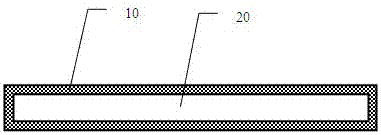Carbon fiber reinforced ultra-temperature vacuum insulated composite material
A composite material and vacuum insulation technology, applied in the field of ultra-high temperature vacuum insulation composite materials, can solve problems such as unsatisfactory and low thermal conductivity, achieve low thermal conductivity, high strength, and realize the effect of structural and functional integration
- Summary
- Abstract
- Description
- Claims
- Application Information
AI Technical Summary
Problems solved by technology
Method used
Image
Examples
Embodiment 1
[0010] refer to figure 1 , a carbon fiber-reinforced ultra-high temperature vacuum insulation composite material consisting of a sealed carbon fiber-reinforced ceramic matrix composite shell and an internal cavity, where [10] is the ceramic matrix composite shell and [20] is the internal cavity cavity. The ceramic matrix composite material shell [10] is composed of carbon fiber reinforced C / C composite material without penetrating pores, in which C fiber accounts for 50% of the volume fraction of the composite material shell, and its inner surface is coated with silicon carbide , the silicon carbide coating penetrates into the interior of the C / C composite material in a gradient distribution, prepares a silicon carbide coating on its outer surface, seals the C / C surface, and the silicon carbide coating penetrates into the interior of the C / C composite material, also presents a gradient distributed. The pressure of the gas in the inner cavity [20] is less than 1000Pa.
Embodiment 2
[0012] The main difference between the second embodiment and the first embodiment is that a layer of zirconium carbide is prepared on the outer surface of the composite shell in the second embodiment. refer to figure 1 , a carbon fiber-reinforced ultra-high temperature vacuum insulation composite material consisting of a sealed carbon fiber-reinforced ceramic matrix composite shell and an internal cavity, where [10] is the ceramic matrix composite shell and [20] is the internal cavity cavity. The ceramic matrix composite material shell [10] is composed of carbon fiber reinforced C / C composite material without penetrating pores. The volume fraction of C fiber in the composite material shell is 60%, and its inner surface is coated with silicon carbide. , the silicon carbide coating penetrates into the interior of the C / C composite material in a gradient distribution, prepares a zirconium carbide coating on its outer surface, seals the C / C surface, and the zirconium carbide coat...
Embodiment 3
[0014] The main difference between the third embodiment and the first embodiment is that in the third embodiment, a layer of silicon carbide is first prepared on the outer surface of the composite shell, and then a layer of zirconium carbide is prepared on the silicon carbide layer. refer to figure 1 , a carbon fiber-reinforced ultra-high temperature vacuum insulation composite material consisting of a sealed carbon fiber-reinforced ceramic matrix composite shell and an internal cavity, where [10] is the ceramic matrix composite shell and [20] is the internal cavity cavity. The ceramic matrix composite material shell [10] is composed of carbon fiber reinforced C / C composite material without penetrating pores, in which C fiber accounts for 50% of the volume fraction of the composite material shell, and its inner surface is coated with silicon carbide , the silicon carbide coating penetrates into the interior of the C / C composite material in a gradient distribution, prepares a ...
PUM
 Login to View More
Login to View More Abstract
Description
Claims
Application Information
 Login to View More
Login to View More - R&D
- Intellectual Property
- Life Sciences
- Materials
- Tech Scout
- Unparalleled Data Quality
- Higher Quality Content
- 60% Fewer Hallucinations
Browse by: Latest US Patents, China's latest patents, Technical Efficacy Thesaurus, Application Domain, Technology Topic, Popular Technical Reports.
© 2025 PatSnap. All rights reserved.Legal|Privacy policy|Modern Slavery Act Transparency Statement|Sitemap|About US| Contact US: help@patsnap.com

